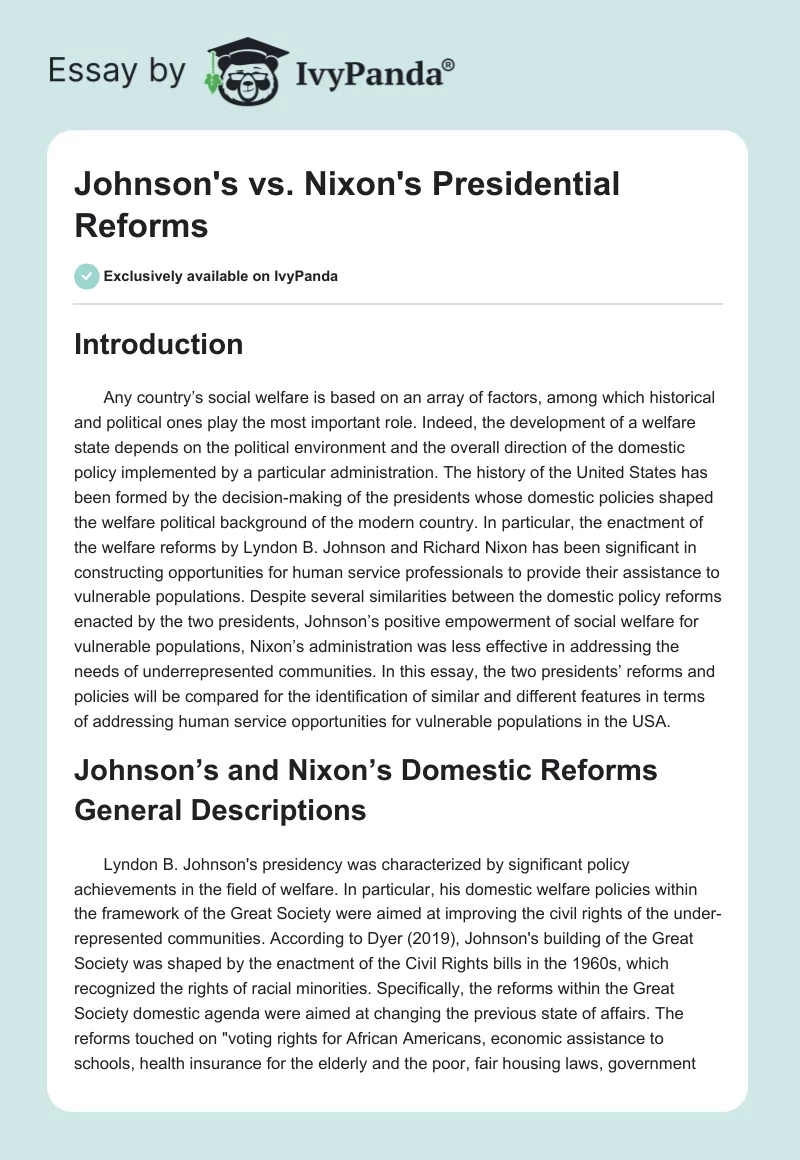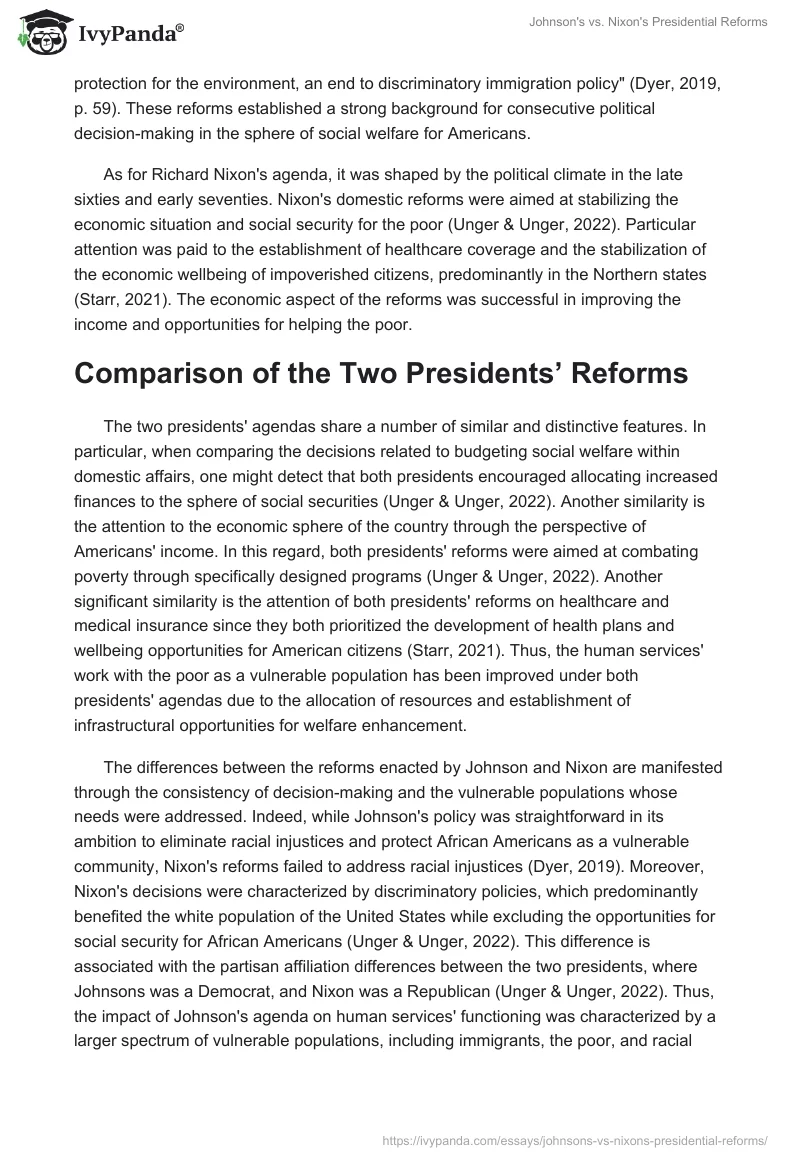Introduction
Any country’s social welfare is based on an array of factors, among which historical and political ones play the most important role. Indeed, the development of a welfare state depends on the political environment and the overall direction of the domestic policy implemented by a particular administration.
The history of the United States has been formed by the decision-making of the presidents whose domestic policies shaped the welfare political background of the modern country. In particular, the enactment of the welfare reforms by Lyndon B. Johnson and Richard Nixon has been significant in constructing opportunities for human service professionals to provide their assistance to vulnerable populations.
Despite several similarities between the domestic policy reforms enacted by the two presidents, Johnson’s positive empowerment of social welfare for vulnerable populations, Nixon’s administration was less effective in addressing the needs of underrepresented communities. In this essay, the two presidents’ reforms and policies will be compared for the identification of similar and different features in terms of addressing human service opportunities for vulnerable populations in the USA.
Johnson’s and Nixon’s Domestic Reforms General Descriptions
Lyndon B. Johnson’s presidency was characterized by significant policy achievements in the field of welfare. In particular, his domestic welfare policies within the framework of the Great Society were aimed at improving the civil rights of the under-represented communities. According to Dyer (2019), Johnson’s building of the Great Society was shaped by the enactment of the Civil Rights bills in the 1960s, which recognized the rights of racial minorities.
Specifically, the reforms within the Great Society domestic agenda were aimed at changing the previous state of affairs. The reforms touched on “voting rights for African Americans, economic assistance to schools, health insurance for the elderly and the poor, fair housing laws, government protection for the environment, an end to discriminatory immigration policy” (Dyer, 2019, p. 59). These reforms established a strong background for consecutive political decision-making in the sphere of social welfare for Americans.
As for Richard Nixon’s agenda, it was shaped by the political climate in the late sixties and early seventies. Nixon’s domestic reforms were aimed at stabilizing the economic situation and social security for the poor (Unger & Unger, 2022). Particular attention was paid to the establishment of healthcare coverage and the stabilization of the economic wellbeing of impoverished citizens, predominantly in the Northern states (Starr, 2021). The economic aspect of the reforms was successful in improving the income and opportunities for helping the poor.
Comparison of the Two Presidents’ Reforms
The two presidents’ agendas share a number of similar and distinctive features. In particular, when comparing the decisions related to budgeting social welfare within domestic affairs, one might detect that both presidents encouraged allocating increased finances to the sphere of social securities (Unger & Unger, 2022). Another similarity is the attention to the economic sphere of the country through the perspective of Americans’ income. In this regard, both presidents’ reforms were aimed at combating poverty through specifically designed programs (Unger & Unger, 2022).
Another significant similarity is the attention of both presidents’ reforms on healthcare and medical insurance since they both prioritized the development of health plans and wellbeing opportunities for American citizens (Starr, 2021). Thus, the human services’ work with the poor as a vulnerable population has been improved under both presidents’ agendas due to the allocation of resources and establishment of infrastructural opportunities for welfare enhancement.
The differences between the reforms enacted by Johnson and Nixon are manifested through the consistency of decision-making and the vulnerable populations whose needs were addressed. Indeed, while Johnson’s policy was straightforward in its ambition to eliminate racial injustices and protect African Americans as a vulnerable community, Nixon’s reforms failed to address racial injustices (Dyer, 2019).
Moreover, Nixon’s decisions were characterized by discriminatory policies, which predominantly benefited the white population of the United States while excluding the opportunities for social security for African Americans (Unger & Unger, 2022). This difference is associated with the partisan affiliation differences between the two presidents, where Johnsons was a Democrat, and Nixon was a Republican (Unger & Unger, 2022).
Thus, the impact of Johnson’s agenda on human services’ functioning was characterized by a larger spectrum of vulnerable populations, including immigrants, the poor, and racial minorities. Nixon’s reforms were less impactful and more discriminatory in terms of promoting holistic human service improvement.
Conclusion
In summation, the comparison of the policies and reforms aimed at instilling social security in the United States by Johnson and Nixon has revealed multiple similarities and differences. In particular, both presidents’ approaches were focused on minimizing poverty levels, improving the accessibility of healthcare, and the overall allocation of significant budgeting to the sphere of human services addressing vulnerable populations.
However, significant differences between the two compared agendas have been detected, which are explained by the party affiliation distinction. Indeed, Johnson’s democratic decisions were aimed at the recognition of racial injustices and the protection of African Americans’ rights, while republican Nixon’s approach was characterized by more attention to the white population’s needs and racism.
References
Dyer, S. E. (2019). Cracking open the golden door: Race, Great Society liberalism, and the immigration reform act of 1965 [Thesis]. Washington and Lee University.
Starr, P. (2021). The health care legacy of the great society. In LBJ’s neglected legacy (pp. 235-258). University of Texas Press.
Unger, I., & Unger, D. (2022). The best of intentions: The triumphs and failures of the great society under Kennedy, Johnson and Nixon. Graymalkin Media.


